INTO IN TO OUT is an interactive installation in which emotions create the space. Through the use of sensors, two participants’ data are measured while facing each other. One’s emotion becomes colour, and the other’s the speed in which these colours change. As they observe the space changing and react, new data is sent, creating a closed loop of feelings and aesthetics. They also have a button each, that triggers confetti falling on the other to trigger more emotions.
HARDWARE AND SOFTWARE
Arduino, TouchDesigner, MaxMSP, GSR and heart rate sensors, laser projectors.
SUPPORT
Supported and powered by Goldsmiths University of London.
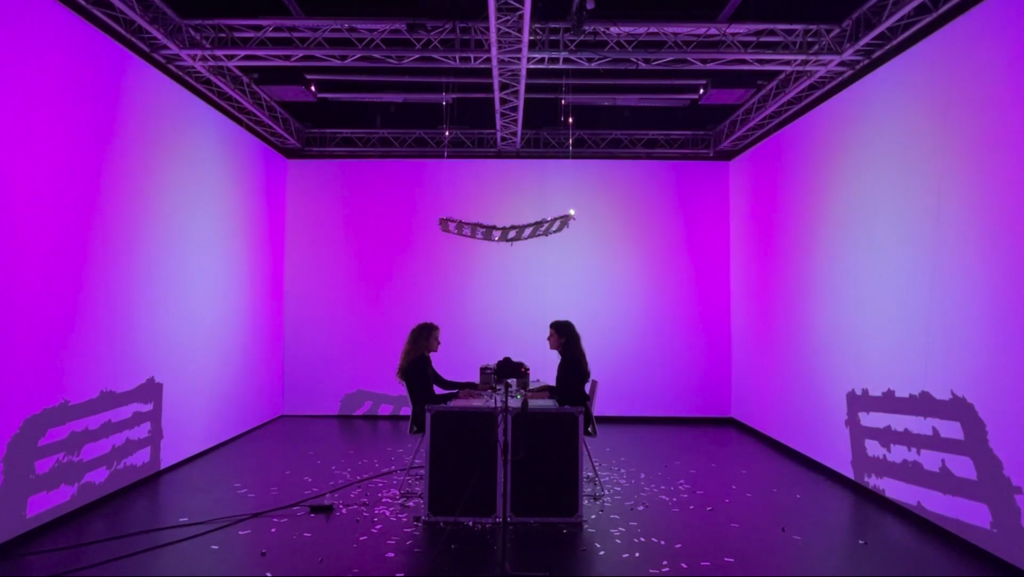



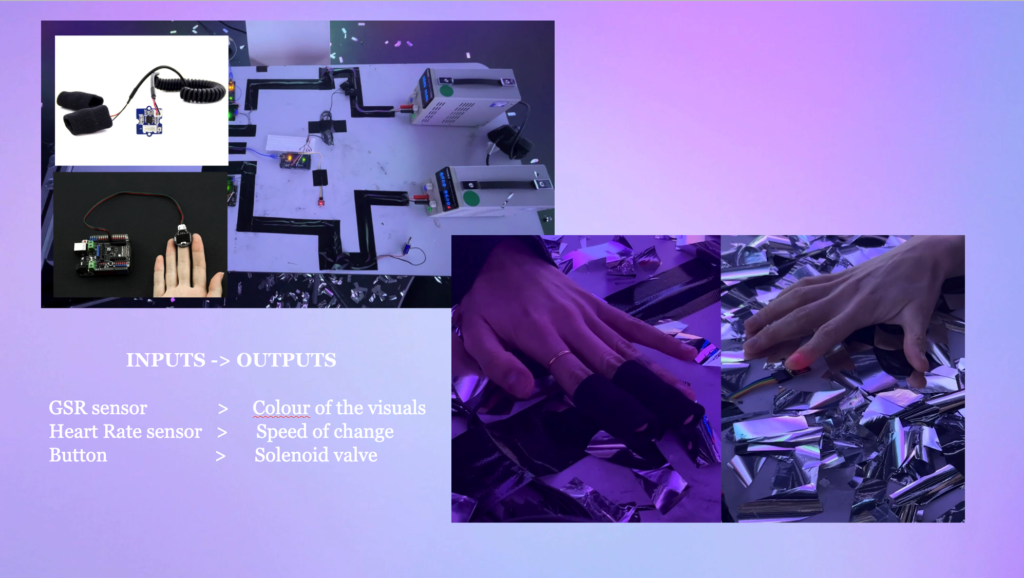
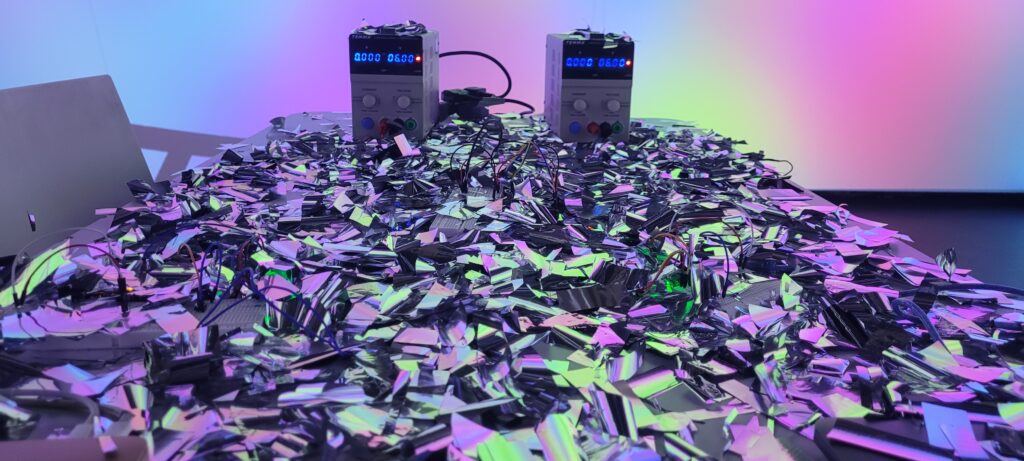
ABOUT
INTO IN TO OUT is an installation in collaboration with Rafa Roeder. This is a research on the process of translation of data sent from one actor, physical or digital, to another. How the repetition of this process affects data and actants, the remains and outcomes in each iteration, what influences the data and how the loop unfolds through time. The starting point of the research is the dynamic between humans and digital. We explore themes such as digital identity and interference in processes and systems of translation between digital and physical spaces. The research addresses technical and philosophical areas: Data, Time, Network connection and the outcome of exploring points of friction in physical – digital relationships. Also the relationship between sensors and actuators using hardwares such as Arduino, screens, LED lights and or other digital devices, as well as softwares as TouchDesigner, Isadora, MaxMSP.
The key questions are the following:
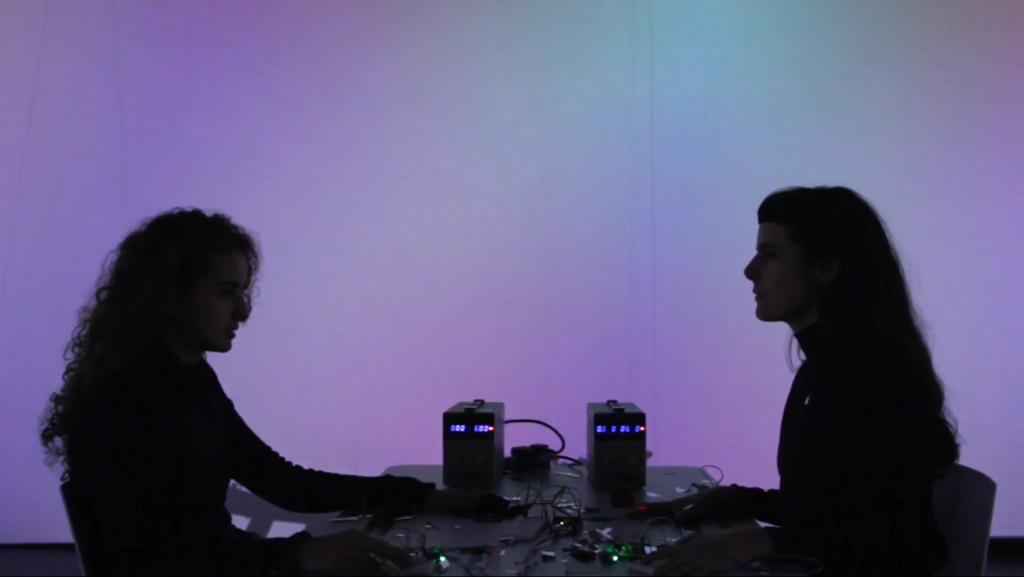
- What are the implications of the process of translation?
- What are the boundaries between physical and digital information that can be retrieved out of a human body?
- Imagining a completely accurate clone of a human. Do we still consider it to not be real? Why? What makes something real?
- Imagining a completely accurate digital replication of a physical space. Do we still consider digital artificial?
- What remains after the retrieval of all data from an actor?
- What is a body? What is its valid structure?
- In the loop of translating physical into digital, is data an actor or a mediator? Is it possible that all actants are equal in their role?
- What is identity? What does it take for something to be considered real?
Our motivation comes from personal experiences and a common ground of imagining different realities. We are intrigued by translating abstract entities like emotions, memories, feelings, consciousness, intuition, dreams into tangible forms. This dimension, not digital nor physical, inspires us to explore the poetics of translation that could emerge. From one perspective, fantasy and imagination is seen as a source of joy both during childhood and the present. The capacity to create alternative realities is what allows us to relate to the world with a sense of hope and excitement, and also plays a significant role in keeping us open-minded towards change and diversity. This process allows exploring translation of these third elements to our current space and time, and exploring different realms of existence. Poetically speaking, we aim at creating a form of “teleportation”, a way to be in parallel spaces.
INTO IN TO OUT is a performative installation of a cycle of translation where data from the body affects the environment. In the installation, two artists use sensors on their bodies, feeding it to a computer that translates it into physical elements like light or sound. As they observe how their data transforms the shared space, a feedback loop is created, influencing both the artist’s experience and the elements in the space. This dynamic between the two artists and space creates a closed loop. The first two actants are humans, whose physical data is translated through next actants, sensors. The data is then sent to the physical outputs to be defined. The third affects the physical space where the two first actants cohabit, and their perception of it.
The main concerns is that the whole translation between digital and physical is perceived for what it is, the action-reaction dynamic must be clear. This would let us communicate precisely our research, while having a simple system that could explore our main interest: the actual process of translation more than the outcomes.
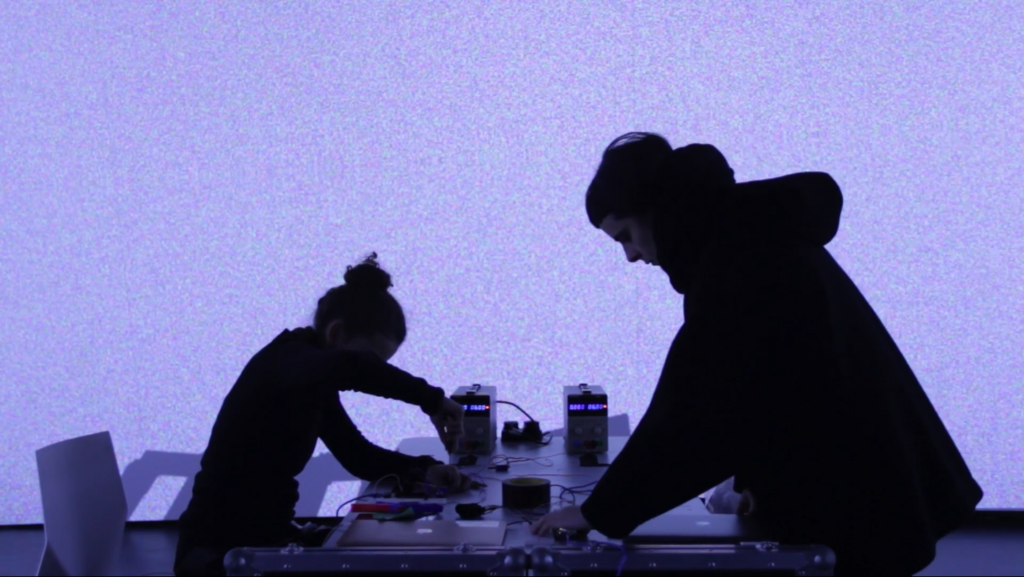
Technical implementation
With this project, we followed our technical expectations: projections’ range of colours changed with mapped emotions from a sensor worn by Ana Sofia, and changed movement with a sensor used by Rafa. Conceptually speaking, the research was a profound realisation that we had absolutely no control of this process whatsoever, letting go of ideals and reflecting on control and causality.
The first example happened while Ana Sofia had headphones on and was mapping the sensor’s data, listening to a meditation to track “calm”, but got scared when someone entered the room. The range spiked from from a lower number to another which was before mapped as “angry”.
In this episode, two key findings emerged: First, abstract thoughts and feelings are not easily traced, challenging the illusion of control over our emotions through external inputs. Secondly, one emotion is never one emotion. Our perception of humanity hopped from a conscious and sentient being to a patchwork of data and non processed feelings that emerge from external input.
When choosing the elements of the space, we wanted to add a material outcome, a physical element apart from ourselves and the technical apparatus, so we decided on confetti. During the experiments, the material looked like dozens of tiny screens falling on us, seeming as an extension of the screens, by reflecting the colours, and ourselves, by being multiplied extensions of our hands touching the other.
Our timeline was the following:
- Place the confetti and camera;
- Sit in front of each other;
- Wear the sensors;
- Look at each other and think: what do we do? What could we possibly talk about?
After different approaches to this moment, from small talk to children’s games, we stop whenever it feels like it should end. There’s no set time, no cues. Then, our anti-timeline begins:
- Stop the camera;
- Blow the confettis out of the table;
- Talk about deeply personal stories, that came naturally in each pause;
- Then, again: place the confetti. Look at each other. What could we possibly talk about?
It was a 12 hour process from the moment we started setting up the environment until we gathered the last confetti. And each time, in the moments of silence between scenes, we unintentionally created this space of looking at our own reflections on the multiplied screens, while picking them up one by one, and carefully placing them in suspension, only to let them cover us all over again.
Eventually, the loop of translation was complete. Physical reactions translate into visuals, that are then seen by us, who watch this process and react to it once again, repeating the cycle. Moreover, we look at each other’s reaction, provoke each other with other physical elements that gently touch us, and we again watch each other’s reaction to that. It’s an infinite cycle of kinesthetic empathy, an exercise of existing outside our own bodies and being trapped by elements born from within us.
References and Bibliography
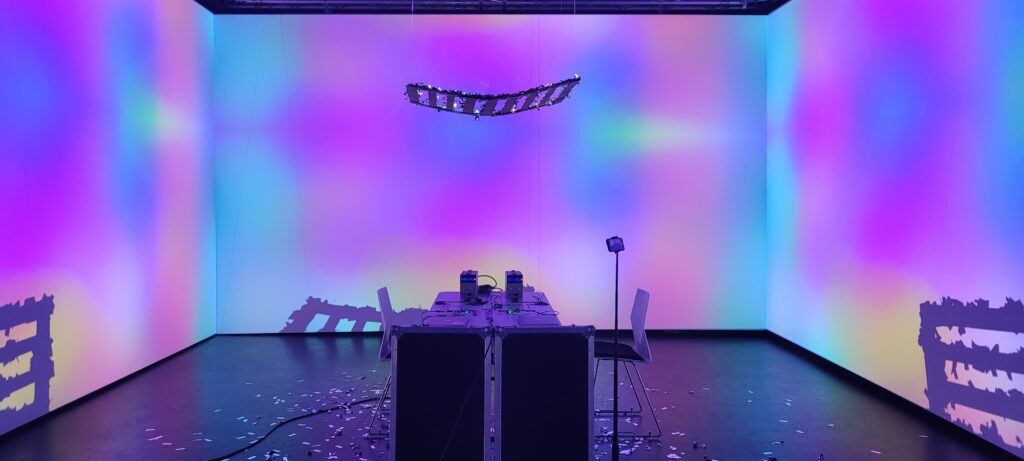
Latour, B. (2005) Reassembling the Social: An introduction to Actor-Network theory.
Haraway, D. (2016) Staying with the Trouble.
Bolter, J. D. (1999) Remediation.
The Woman’s Research Group. (2000) Digital Desires: Language, Identity and New Technologies Cutting Edge.
Hester, H. (2018) Xenofeminism.
Haraway, D., Latour, B. (2020) Interview. [Online] Available at: https://www.youtube.com/watch?v=j-2r_vI2alg (Accessed: 30.10.2023).
Gibson, R., Martelli, B., Porter, P. (n.d.) Dazzle. [Online] Available at: https://gibsonmartelli.com/portfolio/dazzle/ (Accessed: 19.10.2023).
Derivative Thoughtforms: Visualize and 3D Print Your Thoughts. (n.d.) [Online] Available at: https://derivative.ca/community-post/thoughtforms-visualize-and-3d-print-your-thoughts/60710 (Accessed: 26.10.2023).
Roeder, R. 3000 Cuerpos y medio. [Online] Available at: https://vimeo.com/manage/videos/443556741 (Accessed: 11.12.2023).
Pindi, P., Houenou, J., Piguet, C., & Favre, P. (2022). Real-time fMRI neurofeedback as a new treatment for psychiatric disorders: A meta-analysis. Progress in neuro-psychopharmacology & biological psychiatry, 119, 110605. https://doi.org/10.1016/j.pnpbp.2022.110605
Xinyu, W. (2015). Good Medicine Tastes Bitter. Graduate project at Bauhaus University Weimar.
Damasio, Antonio R. (1994). Descartes’ error : emotion, reason, and the human brain. New York :G.P. Putnam.